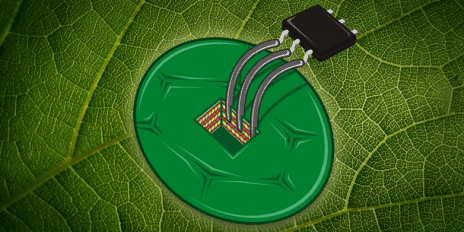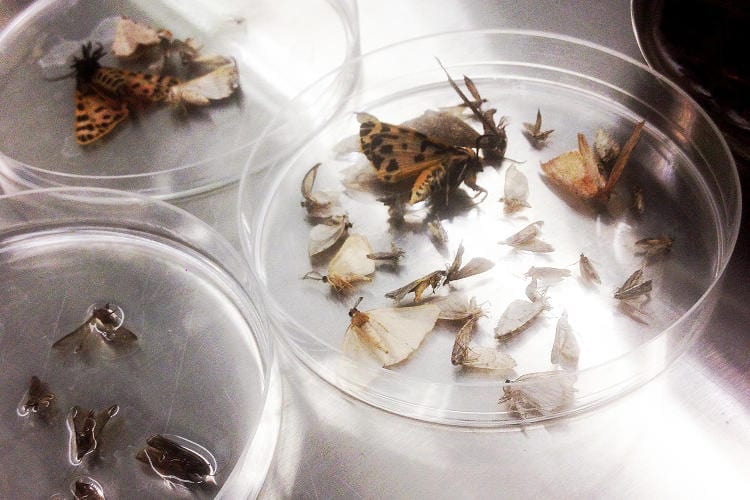
Scientists from ETH Zurich have developed a thermometer that is at least 100 times more sensitive than previous temperature sensors. It consists of a bio-synthetic hybrid material of tobacco cells and nanotubes.
Humans have been inspired by nature since the beginning of time. We mimic nature to develop new technologies, with examples ranging from machinery to pharmaceuticals to new materials. Planes are modelled on birds and many drugs have their origins in plants. Researchers at the Department of Mechanical and Process Engineering have taken it a step further: in order to develop an extremely sensitive temperature sensor they took a close look at temperature-sensitive plants. However, they did not mimic the properties of the plants; instead, they developed a hybrid material that contains, in addition to synthetic components, the plant cells themselves. “We let nature do the job for us,” explains Chiara Daraio, Professor of Mechanics and Materials.
The scientists were able to develop by far the most sensitive temperature sensor: an electronic module that changes its conductivity as a function of temperature. “No other sensor can respond to such small temperature fluctuations with such large changes in conductivity. Our sensor reacts with a responsivity at least 100 times higher compared to the best existing sensors,” says Raffaele Di Giacomo, a post-doc in Daraio’s group.
Water is replaced by nanotubes
It has been known for decades that plants have the extraordinary ability to register extremely fine temperature differences and respond to them through changes in the conductivity of their cells. In doing so, plants are better than any man-made sensor so far.
Di Giacomo experimented with tobacco cells in a cell culture. “We asked ourselves how we might transfer these cells into a lifeless, dry material in such a way that their temperature-sensitive properties are preserved,” he recounts. The scientists achieved their objective by growing the cells in a medium containing tiny tubes of carbon. These electrically conductive carbon nanotubes formed a network between the tobacco cells and were also able to penetrate the cell walls. When Di Giacomo dried the nanotube-cultivated cells, he discovered a woody, firm material that he calls ‘cyberwood’. In contrast to wood, this material is electrically conductive thanks to the nanotubes, and interestingly the conductivity is temperature-dependent and extremely sensitive, just like in living tobacco cells.
Touchless touchscreen and heat-sensitive cameras
As demonstrated by experiments, the cyberwood sensor can identify warm bodies even at distance; for example, a hand approaching the sensor from a distance of a few dozen centimetres. The sensor’s conductivity depends directly on the hand’s distance from the sensor.
Read more: From tobacco to cyberwood
The Latest on: Bio-synthetic hybrid material
[google_news title=”” keyword=”Bio-synthetic hybrid material” num_posts=”10″ blurb_length=”0″ show_thumb=”left”]
via Google News
The Latest on: Bio-synthetic hybrid material
- Silk, The Ancient Material With High-Tech Possibilitieson April 25, 2024 at 11:47 am
Silk: A World History” describes the unique qualities of silk that make it a sustainable material with a wide variety of applications.
- Self-assembling synthetic cells act like living cells with extra abilitieson April 23, 2024 at 5:00 pm
Blurring the line between artificial and living materials, these cells can be reprogrammed to perform multiple functions, opening the door to new synthetic biology tech that goes beyond nature’s ...
- Beyond biology: Creating dynamic synthetic cells with programmable DNAon April 22, 2024 at 4:59 pm
"This research helps us understand what makes life," Freeman says. "This synthetic cell technology will not just enable us to reproduce what nature does, but also make materials that surpass biology." ...
- Bio-Based Insulation Textiles Instead Of Synthetic Insulation Materials Are Set To Revolutionize The Construction Worldon April 20, 2024 at 9:29 am
The bio-based recyclable insulation textiles consist of 100 percent bio-based aerogel-fibres. They contain up to 90 percent air, trapped in the nano-pore system of the aerogel-fibres. The bio-based ...
- The Moto Edge 50 Ultra revived the wooden phone, so can we get a Lego one next?on April 18, 2024 at 7:22 am
What is essential is invisible to the eye, but the Little Prince forgot to add something. Not every great phone out there is defined by its chipset, graphics processing unit, or its silky-smooth ...
- Bcomp closes US $40M Series C funding to foster mobility decarbonisation with high-performance bio-based materialson April 16, 2024 at 8:24 am
Bcomp, the global leader in high-performance, natural fibre composites for the mobility-, recreational-, and mass transportation sectors and listed as a top 100 Global Cleantech Company, today ...
- I've been sleeping on an adjustable pillow for a month — here are 3 things to know before buyingon April 14, 2024 at 3:30 am
The Simba Hybrid Pillow allows you to adjust its height and softness for customised comfort. But after sleeping on it for a month, these are 3 things you need to know before buying.
- 10 Best Cooling Mattresses That Feel Like the Other Side of the Pillowon April 12, 2024 at 10:26 am
Glowing Customer Review: "The Bear Natural is a new latex hybrid that hits all the right marks. It’s cushioning and bouncy from the latex comfort layer and supportive in all the right places from the ...
- These Cooling Mattresses Will *Actually* Keep Their Chill at Night (Promise)on April 12, 2024 at 3:26 am
But that won't be a problem with the AS3 Hybrid, which uses proprietary Bio-Pur material with an open ... memory foam and can be made with natural materials (unlike PU foam and memory foam, which are ...
- Harnessing the Power of Microalgae-Material Hybrids Paving the Way to Carbon Neutralityon March 26, 2024 at 3:27 am
In the quest for sustainable solutions to mitigate climate change and achieve carbon neutrality, researchers are turning to nature’s biological systems for inspiration. Among these systems, microalgae ...
via Bing News










